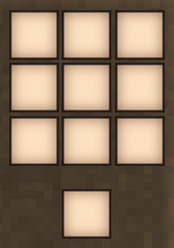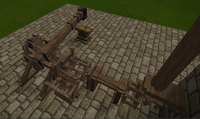Martinete
Un Martinete es una herramienta utilizada para trabajar el hierro en lingotes sobre un yunque en herrería, así como para fabricar placas de metal.
Creación
Un martinete utilizable se compone tanto del propio martillo como de la estructura que lo rodea: la base del martinete y la palanca. Si es necesario, se puede utilizar un freno o un sistema de transmisión y embrague para detener el martinete.
A useable helve hammer comprises of both the actual hammer, as well as the structure around it - the helve hammer base and toggle. Optionally, a brake or a transmission & clutch setup can be used to stop the helve hammer if necessary.
Martinete
La materia prima utilizada para crear el cabezal de la herramienta determina el proceso artesanal necesario:
The raw material used to create the tool head determines the crafting process required:
A diferencia de otros martillos, el martinete no tiene durabilidad, por lo que el material utilizado para fabricar la cabeza no tiene ningún efecto en la herrería. Los posibles metales para la cabeza del martinete son los siguientes:
| Material |
|---|
| Bronce de estaño |
| Bismuth Bronze |
| Black Bronze |
| Iron |
| Material |
|---|
| Tin Bronze |
| Bismuth Bronze |
| Black Bronze |
| Iron |
Después de crear el cabezal de la herramienta, hay que montar el martinete en la grilla de fabricación:
| Ingredients | Crafting Recipe |
|---|---|
| 1x Helve hammer head 8x Tablas |
Base de martinete e Interruptor de madera
La base del martinete sujeta a el martinete, mientras que el interruptor conecta el brazo del martillo al circuito de alimentación.
Freno, Transmisión & Embrague (opcional)
Un freno puede utilizarse para detener completamente un tren de potencia. Una transmisión, en cambio, interrumpe un tren de potencia temporalmente o separa dos partes del tren. Para utilizar una transmisión, es necesario colocar un embrague a su lado, que funciona de forma similar al freno.
| Ingredients | Crafting Recipe |
|---|---|
| Brake: 1x Martillo 1x Cincel 1x Tronco 1x Energía mecánica 2x Resina |
Usos
El martinete es la principal herramienta utilizada en la herrería mecanizada, y se emplea para automatizar procesos como el trabajo de horneado de hierro y la fabricación de planchas de metal.
Consulta la página Energía mecánica para obtener más información sobre la generación de energía y los trenes de potencia.
- See also Mechanical Power
The helve hammer is used for automated smithing, and is used to automate processes such as working iron blooms and making metal plates. The helve hammer can only be used to process iron blooms into ingots, and to produce iron plates. Helve hammers can also repair iron blooms that are missing voxels due to user error.
Manejo manual
El martillo helicoidal no puede utilizarse sin enería mecánica, ni puede sustituir al martillo en la grilla de fabricación.
The helve hammer cannot be used without mechanical power, nor can it substitute for the hammer in grid crafting.
Funcionamiento automatizado
Los martinetes requieren energía mecánica para funcionar correctamente, y pueden ser bastante exigentes para la configuración de potencia. Para más información sobre la generación de energía y los trenes de potencia, véase Energía Mecánica. Con una dotación completa de aspas, el martinete funcionará, aunque lentamente, a velocidades de viento tan bajas como el 30%.
Helve hammers require mechanical power to run properly, and can be quite taxing for the power setup. For more info on power generation & power trains, see mechanical power. With a full complement of sails, the helve hammer will function, albeit slowly, at wind speeds as low as 30%.
- Power Input: The helve hammer must be powered by connecting the incoming axle on the left or right of the toggle and cannot be powered by connecting the axle to the top or bottom of the machine.
- The helve hammer base should be placed with the long arm of the triangular support and crossbeam facing the direction the player intends to place the hammer. The sloped sides of the base are the back of the block, and the helve hammer will further place directionally. An anvil needs to be placed three blocks away from the base in the same direction, so be sure to have enough free space in front the base.
- The toggle must be placed adjacent to the helve hammer base, at the upward sloping side towards the anvil. The toggle places sideways, be sure to orient the toggle such that the square frames continue the frame of the helve hammer base. The input axle cannot be placed on the frameless sides of this block.
- Then add the helve hammer itself onto the base. When placed correctly, the helve hammer will snap with the toggle and should rest on the anvil when not in use. When placed on the base, the helve hammer requires two blocks to move freely through its arc.
- The brake (optional) can be placed on the opposite side of the axle leading into the base. It can be used to completely stop the whole power train the helve hammer is connected to.
- A transmission and clutch setup (optional) can be used as a temporary brake or to separate the helve hammer from the rest of the power train. The transmission needs to be placed between the helve hammer toggle and the power input, functioning as an interrupted axle. The clutch can then be placed on its side - only when the clutch is engaged with a right click will the transmission actually transfer power. This setup is especially helpful when working with low power input or a complicated power train, as it allows to disengage the power-intensive helve hammer from the rest of the train if needed.
- Material Input: Blooms or ingots need to be placed by hand on top of an anvil placed under the helve hammer's head. They need to be heated to the appropriate temperature, just as if smithing by hand - however, with high wind power, the helve hammer will potentially take less time then manual smithing would.
- Material Output: Processed items will simply fall off the anvil after they are finished. Since there is no way to automate the Input, there is no profit in automating the Output, as is possible for instance for the quern.
Combate
El martinete tiene un alcance de 3m, pero no tiene potencia de ataque, por lo que no puede utilizarse en combate.
While the helve hammer has a 3m range, it has no attack power stat and can therefore not be used in combat.
Almacenamiento
A diferencia de otras herramientas, el martinete no puede colocarse en un soporte de herramientas. Los martillos helve no se apilan en el inventario ni cuando se colocan en contenedores.
Unlike other tools, the helve hammer cannot be placed on a tool rack. Helve hammers do not stack in inventory or when placed in containers.
See also
Gallery
| Ores, metals and minerals | |
|---|---|
| Guides | Ore Deposits • Metals |
| Metals | Copper • Iron • Meteoric iron • Gold • Silver • Lead • Tin • Zinc • Bismuth • Titanium (Ilmenite) • Nickel |
| Alloys | Bronze (Tin bronze, bismuth bronze, black bronze) • Steel • Brass • Solder (Lead solder, Silver solder) • Molybdochalkos • Cupronickel • Electrum |
| Minerals | Alum • Borax • Cinnabar • Coal • Halite (Salt) • Lapis lazuli • Quartz • Saltpeter • Sulfur • Sylvite (Potash) |
| Tools | Pickaxe • Hammer • Prospecting Pick • Crucible • Forge • Ore blasting bomb • Quern • Anvil • Bloomery • Helve hammer • Pulverizer |
| Other | Gemstones |
| Related mechanics | Panning • Mining • Clay forming • Casting • Smithing • Steel making |
| Wiki Navigation | |
|---|---|
| Vintage Story | Guías • Preguntas más frecuentes (FAQ) • Vintage Story Original Soundtrack • Versiones • Controles |
| Mecánicas de juego | Fabricación • Talla Lítica • Alfarería • Herrería • Cocina • Temperatura • Hambre • Minería • Estabilidad temporal • Energía mecánica • Comercio • Agricultura • Ganadería |
| Mundo | Generación del Mundo • Biomas • Clima • Tormentas temporales |
| Objetos | Herramientas • Armas • Armadura • Ropa • Mochilas • Materiales • Comida |
| Bloques | Terreno • Plantas • Decorativo • Iluminación • Functional • Minerales |
| Entidades | Entidades hostiles • Animales • NPCs • Jugadores |
| Miscellaneous | List of client commands • Lista de comandos del servidor • Creative Starter Guide • Bot System • Cómo utilizar Worldedit • Cinematic Camera • Adjustable FPS Video Recording • ServerBlockTicking |

